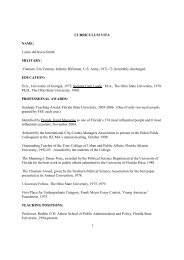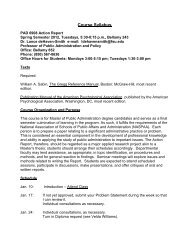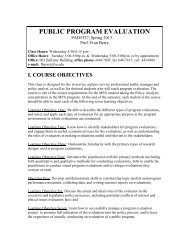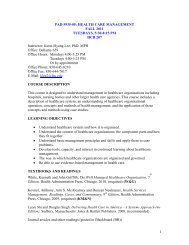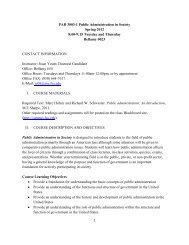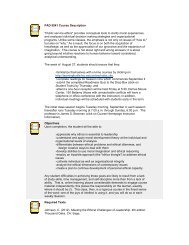PAD 5701 Quantitative Analysis Fall 2012 Thursday, 5:30-8:15 PM ...
PAD 5701 Quantitative Analysis Fall 2012 Thursday, 5:30-8:15 PM ...
PAD 5701 Quantitative Analysis Fall 2012 Thursday, 5:30-8:15 PM ...
You also want an ePaper? Increase the reach of your titles
YUMPU automatically turns print PDFs into web optimized ePapers that Google loves.
<strong>PAD</strong> <strong>5701</strong> <strong>Quantitative</strong> <strong>Analysis</strong><br />
<strong>Fall</strong> <strong>2012</strong><br />
<strong>Thursday</strong>, 5:<strong>30</strong>-8:<strong>15</strong> <strong>PM</strong><br />
314 HCB<br />
Dr. Jayce L. Farmer<br />
Office Hours: Tuesday & <strong>Thursday</strong> 3:00 – 5:00 or by appointment<br />
Office: 650 Bellamy<br />
Phone: 645-1914<br />
E-Mail: jfarmer@fsu.edu<br />
All course materials and instructional changes will be posted on the course’s Blackboard site.<br />
All students must obtain an FSU e-mail account in order to receive messages from the<br />
Blackboard system. FSU’s Blackboard address is http://campus.fsu.edu/webapps/login.<br />
Students not familiar with Blackboard can visit its resource website at<br />
http://resources.blackboard.com/scholar/general/pages/ictraining/. Students may also contact<br />
the computer lab or computing services for help.<br />
Course Description and Learning Objectives<br />
This course is the second of the 5700-<strong>5701</strong> sequence of introductory statistics courses. While<br />
the first stresses research design issues, this one concentrates on the utilization and<br />
appropriateness of statistical techniques in the assessment of collected data. Statistics is a<br />
valuable tool that can be used to help public and non-profit managers, or any other<br />
professionals make sound decisions based on the given evidence of data. It contributes to<br />
students’ analytical understanding of such subjects as program evaluation, performance<br />
management, impact assessment, and policy analysis. Upon taking this class, students will be<br />
able to:<br />
• Manage collected data appropriate to a research design<br />
• Present descriptive information of data graphically<br />
• Understand the logic of statistical inference and hypothesis testing<br />
• Know how to use data to improve managerial decisions<br />
• Conduct basic statistical tests such as the T-test, One-Way ANOVA, and linear<br />
regression<br />
• Develop interpretative skills for various statistical tests<br />
• Develop basic computer skills in analyzing statistical data.<br />
Prerequisites and Assumptions<br />
• A “B-“ or better in <strong>PAD</strong> 5700<br />
• College-level algebra skills<br />
Required Textbook<br />
Meir, Brudney, & Bohte. Applied Statistics for Public & Nonprofit Administration, 8 th ed. (4 th<br />
edition or higher is acceptable). Boston Duxbury Press. Earlier editions may have different<br />
chapter sequences and slightly different content.<br />
The book can be found at the FSU Bookstore, Bill’s Bookstore, www.amazon.com, or<br />
www.bestbookbuys.com.
Additional materials may be posted on the course’s blackboard website.<br />
Required Instruments<br />
• Calculator: Bring a calculator for each class, as occasionally one will be need. A simple<br />
calculator with basic functions will suffice.<br />
• SPSS: Access to SPSS is required. The student version or more sophisticated full<br />
version can be obtained from the bookstores or online. However, the software is<br />
available on several computers located in many computer labs throughout campus,<br />
including our school’s lab located on the 6 th floor of the Bellamy building. Students are<br />
allowed to obtain assistance from lab assistants, doctoral students, or any other sources<br />
regarding the use of SPSS (as long as it is not directly related to graded assignments).<br />
If there are any computers in our department lab that does not have SPSS, please let<br />
me know immediately.<br />
• Excel: Access to Excel is required.<br />
Course Evaluation<br />
Grades will be assessed only by the following, which means no extra credit will be given:<br />
• Homework assignments (three) – <strong>15</strong>%<br />
• Midterm (open notes) - <strong>30</strong>% (November 1)<br />
• <strong>Quantitative</strong> research paper – 25%<br />
• Final exam (open book, open notes) – <strong>30</strong>% (December 13)<br />
Letter grades will be assigned as follows: A=93 or higher; A-=90 to 92.99; B+=87.5 to 89.99;<br />
B=82.5 to 87.49; B-=79.5 to 82.49 (anything less than a B- is considered as failing this course,<br />
thus resulting in the student having to re-take in a future semester); C+=77.5 to 79.49; C=72.5<br />
to 77.49; C-=69.5 to 72.49; D+=67.5 to 69.49; D=62.5 to 67.49; D-=59.5 to 62.49; F= anything<br />
less than 59.5.<br />
No grade adjustments will be made after the final exam<br />
Incomplete: A grade of incomplete (“I”) will be given if unforeseeable circumstances keep you<br />
from completing the course requirements within the normal semester. If you request an “I,”<br />
please submit the necessary documentation to prove the “circumstances” (either work or<br />
personal related). Please do not ask the instructor whether you need to bring documentation to<br />
prove – you must.<br />
Late Assignments:<br />
• No late homework will be accepted, as the answers will be discussed in class.<br />
• Late research papers will be deducted one letter grade.<br />
• A make-up mid-term exam may be given if you bring documentation proving any<br />
unforeseen circumstances (such as work or personal related). Please keep in mind that<br />
the instructor reserves the right to not accept any documented excuses.<br />
• No make-up final exam will be given.<br />
Group Assignments: Over the course of the semester, the instructor will require students to<br />
work together in groups for homework assignments. All groups and group members will be<br />
organized and chosen by the students. Consequently, it is the students’ responsibility to ensure<br />
that all group participants complete their portions of the assignments, as well as complete them<br />
on time. Good public and non-profit managers often have to put aside their differences to<br />
organize and work with others in order to get things accomplished.
Other Policies<br />
Syllabus Changes: The instructor reserves the right to alter the syllabus as deemed necessary.<br />
Students will be notified of syllabus changes via the class Blackboard site or by e-mail.<br />
Academic Honesty: Borrowing and building upon others’ ideas is acceptable, but presenting<br />
those ideas as our own without acknowledging it is not. All written work should have a<br />
bibliography (or references section) using a standard format (APA style preferred).<br />
To avoid plagiarism, you are advised that:<br />
1. If you take material that is not yours, from any source whatsoever, and copy it into<br />
assignments for this class, you must provide a footnote, endnote, or parenthetical reference<br />
to the source of the material.<br />
2. Any material which quotes verbatim from other sources must be enclosed in quotation<br />
marks and its source attributed as noted in rule #1 above.<br />
3. Material not taken verbatim from a text but paraphrased must be attributed as in rule #1.<br />
4. Violations of these rules in any assignment may be subject to a minimum penalty of a grade<br />
of zero for the assignment and may result in a grade of “F” for the course.<br />
You are expected to uphold the Academic Honor Code published tin the Florida State University<br />
Bulletin and the Student Handbook. The Academic Honor Policy outlines the University’s<br />
expectations for the integrity of students’ academic work, the procedures for resolving alleged<br />
violations, and the rights and responsibilities of students and faculty members throughout the<br />
process. Students are responsible for reading the policy and living up to their pledge as can be<br />
found at http://dof.fsu.edu/honorpolicy.htm. Violations to these rules in any assignment may be<br />
subject to a minimum penalty of failing grade for the assignment and could result in a grade of<br />
“F” for the course.<br />
Accommodations for Students with Disabilities: Students with disabilities needing academic<br />
accommodation should: 1) register with and provide documentation to the Student Disability<br />
Resource Center (SDRC); and 2) bring a letter from the SDRC to the instructor indicating the<br />
need for accommodation and what type. This should be done during the first week of class.<br />
This syllabus and other class materials are available in alternative format upon request. For<br />
more information about services available to FSU students with disabilities, contact:<br />
SDRC at (850) 644-9566 (voice); (850) 644-8504 (TDD); e-mail: sdrc@admin.fsu.edu;<br />
http://www.disabilitycenter.fsu.edu/<br />
<strong>Quantitative</strong> Research Paper<br />
Students will be required to write and submit a research paper that displays your ability to<br />
conduct a quantitative analysis of some topic in public or nonprofit administration (APA style,<br />
Double-spaced, 12 point font written in Times New Roman, Arial, Courier, Cambria or Calibri.<br />
Page parameters are up to you, but please do not exceed 25 pages). Unlike the research<br />
proposal paper that you should have done in <strong>PAD</strong> 5700, this paper will require you to conduct<br />
an actual analysis and present/analyze empirical findings. This paper will require you to use<br />
any method of statistical analysis that you have learned in class. Thus, your paper should be a<br />
quantitative research paper, and not qualitative. Keep in mind that quantitative research
equires analysts to use standardized measures that fit diverse phenomena into predetermined<br />
categories. These phenomena are then analyzed using some form of statistical analysis. On<br />
the other hand qualitative research permit analysts to study a small number of selected issues,<br />
cases, or events in depth and in detail. Here, data are not constrained to fixed categories and<br />
are normally not analyzed using numerical measurements.<br />
Your paper will consist of a research question, hypotheses surrounding that research question<br />
and methods of analysis that analyze your hypotheses. The following highlight the full<br />
requirements of the paper:<br />
o<br />
o<br />
o<br />
o<br />
o<br />
o<br />
o<br />
o<br />
o<br />
o<br />
o<br />
Title page<br />
Executive summary or Abstract<br />
Introduction that presents the problem to be analyzed and your research<br />
question (AKA your problem statement)<br />
Review of literature that highlights the issues or prior research regarding your<br />
research question (the literature review develops your conceptual framework and<br />
should give support to your hypotheses)<br />
Hypotheses (these can be included in the literature review section, given their<br />
own section that highlights your conceptual framework or included in the<br />
description of your methods. This depends on the flow of your paper)<br />
Methods<br />
§ Data description, use of data and origin<br />
§ Variable description and operation<br />
§ Brief description of statistical method<br />
§ Descriptive statistics<br />
Findings (This section will describe the results of your statistical analysis and<br />
present any tables, charts or visuals that illustrate your findings.)<br />
Discussion (This section will elaborate your findings within the context of your<br />
conceptual framework. Did the results support or refute your hypotheses Do<br />
your results contribute to or contest the conceptual framework Why or why not<br />
Conclusion (Tie the summary of your findings in with your research question.<br />
What are the implications of your answer to the research question How does<br />
your answer to the research question address the problem you stated at the<br />
beginning Basically, what should we have learned from your research Finally,<br />
how does your research contribute to the literature or how can it assist policy<br />
makers in their decisions Can further research be done on this topic If so,<br />
how)<br />
Appendices (if applicable)<br />
References (The reference list should consist of at least 10 references, of which<br />
the majority should come from reputable books (found in the library), academic<br />
journals or government documents)
Course Outline<br />
Keep in mind that the following schedule may change during the term based upon class<br />
progress.<br />
Week 1: Introduction 8/<strong>30</strong><br />
Discussing syllabus, Blackboard, SPSS, and other requirements<br />
Go to lab and play with SPSS<br />
Week 2: Foundations of a Research Design 9/6<br />
Read text: Chap 2 & 3<br />
• Understand the basic components of a research design<br />
• Know what is to be expected in the quantitative research paper<br />
Think about topic for research paper (have topic ready to present to class on 9/13)<br />
Week 3: Frequency Distributions 9/13 (meet in department lab if available)<br />
Read text: Chap 4<br />
• Choose an appropriate graph to present data in a research paper<br />
• Draw a histogram, bar chart, and a frequency polygon using SPSS and Excel<br />
to produce graphs<br />
Be ready to present research paper topic<br />
Week 4: Measures of Central Tendency and Dispersion 9/20<br />
Read text: Chap 5 & 6<br />
Calculate the mean, median and mode<br />
• Choose the appropriate measure of central tendency for a given question<br />
• Present the meaning of standard deviation<br />
Homework assignment 1 available on Blackboard site after class (due 10/4)<br />
Week 5: Probability and Normal Probability Distribution 9/27 (meet in department lab)<br />
Read text: Chap 7 & 8<br />
• Summarize the features of a normal distribution<br />
• Calculate the Z score and use the Z score table<br />
Week 6: Inferential Statistics 10/4<br />
Homework 1 due at beginning of class<br />
Read text: Chap 11 & 13<br />
• Know the meaning of the t distribution<br />
• Know the meaning of the standard error and t value and how to calculate<br />
• Calculate confidence limit for proportions & percentages<br />
Be ready to present an update on research paper progress<br />
Homework assignment 2 available on Blackboard (due 10/18)<br />
Week 7: Hypothesis Testing 10/11 (meet in department lab)<br />
Read text: Chap 12<br />
• Formulate a null and working hypothesis<br />
• Conduct one and two-tailed tests<br />
• Understand type I and type II errors<br />
• Determine sample size
Week 8: Testing the Difference between Groups 10/18 (meet in department lab if available)<br />
Homework 2 due at the beginning of class<br />
Read text: Chap 14<br />
• Use two sample t-test<br />
• Use SPSS for two group sample t-test<br />
• Interpret SPSS results<br />
Week 9: <strong>Analysis</strong> of Nominal and Ordinal data 10/25<br />
Read text: Chap <strong>15</strong><br />
• Be able to use contingency table<br />
• Discussion of parametric and non-parametric tests<br />
• Introduction to One-Way ANOVA<br />
Be ready to present a short update on research paper progress (data collection)<br />
Week 10: Midterm Exam 11/1<br />
Week 11: Statistical Significance of Contingency tables 11/8<br />
Read text: Chap 16<br />
• Use Chi-square test<br />
• Use other measures of association<br />
Week 12 Introduction to Regression <strong>Analysis</strong> 11/<strong>15</strong> (meet in department lab if available)<br />
Read text: Chap 18, 19 & 21<br />
• Understanding B.L.U.E.<br />
• Understanding the linear & multiple regression processes and assumptions<br />
• Running regressions in SPSS<br />
Homework 3 Available on BB<br />
Week 13: No class Thanksgiving Day 11/22<br />
Week 14: Introduction to Regression <strong>Analysis</strong> (continued) 11/29<br />
Homework 3 due<br />
• Understanding the coefficient and determination<br />
• Interpreting regression results<br />
Week <strong>15</strong> <strong>Quantitative</strong> Research Papers Due 12/6<br />
Students give a short presentation on research paper, briefly discuss:<br />
• Research question and importance<br />
• Data collection and methods<br />
• Findings<br />
Week 16: Final Exam 12/13 (Regular class time)



